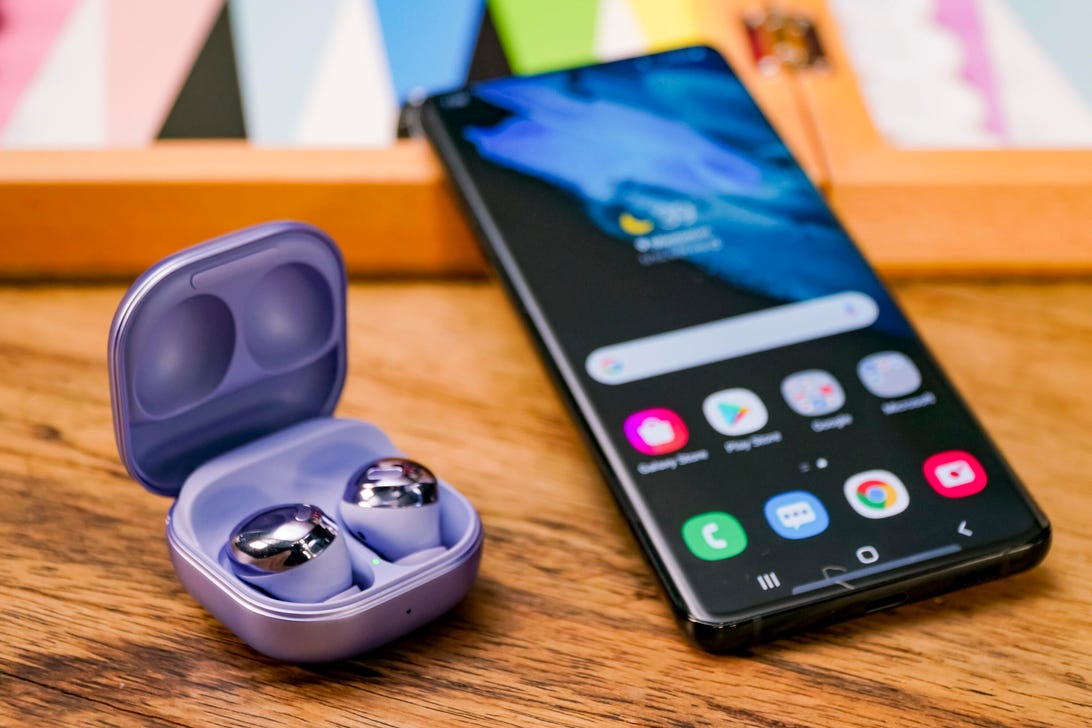
Qualcomm wants to make it easier to pair earbuds to Android mobile devices.
Drew Evans/CNET
Some of the best features of Apple’s AirPods may soon come to non-Apple Bluetooth headphones, thanks to a push by Qualcomm.
One of the biggest benefits of using AirPods Pro or Beats headphones with iPhones, iPads and other Apple devices, reviewers say, is that they “just work.” The earbuds pair quickly with Apple products, they automatically switch between a user’s iPhone and Mac, and features like spatial audio and noise cancellation boost the sound capabilities. That’s largely thanks to the fact Apple designs the technology in both its mobile devices and its headphones, letting it optimize for the features it wants. Now mobile chip giant Qualcomm plans to help Android handset vendors and third-party audio designers offer the same experience to their users, no Apple magic needed.
Stay tuned
Subscribe to the CNET TVs, Streaming and Audio newsletter for the best of our home entertainment coverage.
Qualcomm on Thursday unveiled its new Snapdragon Sound technology that allows for better audio and easier pairing between earbuds and Android devices, PCs and maybe even TVs. Snapdragon Sound is dependent on hardware and software, so it will only appear in new devices, and it will first come to headphones paired with high-end Android phones.

Now playing:
Watch this:
Chip supplies are scarce, and it may not get better till…
7:10
With Snapdragon Sound, calls and music are meant to be crisp and clear with high-resolution, 24-bit 96kHz audio; sound delivered over Bluetooth to be “glitch-free,” meaning fewer dropped calls and static; the lag between the sound leaving a phone and arriving at the earbuds to be 89 milliseconds, allowing for immersive gaming and better conference calls; and battery life to be longer than what’s typical in earbuds today.
The need for better wireless audio has become obvious during the novel coronavirus pandemic, said Cristiano Amon, Qualcomm’s president and, in June, CEO. People are on multiple video calls during the day, they’re gaming in the evening and listening to music in their spare time. Having “just fine” audio isn’t enough.
“There was an opportunity really to create a premium audio experience,” Amon said in an interview ahead of the news. “Part of the experience of being in your phone [or] on your PC is the audio.”
Apple’s devices work better together, but for the Android ecosystem, it’s not that simple. The Android world is fragmented, with everyone from Samsung to small Chinese brands making phones. And Android device users don’t always buy Bluetooth earbuds from the same companies that design their phones. Instead, they may seek out products from audio-focused companies like Bose or Jabra and use them with their OnePlus phones. Getting a seamless experience isn’t as easy as when buying everything from Apple. Qualcomm wants to change that.
It wants “to go for the best possible audio experience you can get over a wireless connection and do it in a way that’s as seamless as you get with an Apple-only ecosystem,” Technalysis Research analyst Bob O’Donnell said.
Improving audio
Multiple pairs of headphones can connect to the same phone or PC, letting people listen to music together, and Qualcomm later on will bring some features found in AirPods to Snapdragon Sound. That includes spatial audio — which makes sound more immersive by giving the impression that audio is coming from all around you — and the ability for headphones to automatically move from a phone connection to a PC, based on what you’re using at the time.
Both the source device — like an Android phone — and the headphones need to have Qualcomm Bluetooth chips to work, and at first, Snapdragon Sound will appear in phones with Qualcomm’s ultra-premium Snapdragon 888 chipset. The chipset arrived last month in Samsung’s Galaxy S21 and will likely power most high-end Android phones this year. While Snapdragon Sound is first arriving in Snapdragon 888-powered devices, Qualcomm eventually plans to bring Snapdragon Sound to its chipsets for less expensive phones.
And it will expand it to Snapdragon-powered computers released later this year or in early 2022. Even Intel- and AMD-powered Windows PCs can work with Snapdragon Sound, as long as they use Qualcomm’s newer Bluetooth chips, said Rahul Patel, Qualcomm senior vice president and general manager of connectivity. And TV makers that use Qualcomm’s Bluetooth chips could offer it, he said.
“This reduces the development time,” Patel said in a meeting with reporters ahead of the news. And for consumers, “you have the ability to pick and choose … Bose headphones or Jabra headphones and expect the same level of vertical integration as you would have from … [a] company that does earbuds as well as the phone.”
Snapdragon Sound includes Qualcomm’s Snapdragon 888 processor; its FastConnect 6900 mobile connectivity system; active noise-canceling technology; several Qualcomm Bluetooth processors; the company’s AptX codec for super wideband voice and low latency; its Aqstic audio codec and smart speaker amplifiers; and the Qualcomm audio and voice communication suite software.
Xiaomi plans to introduce one of the first phones that works with Snapdragon Sound, while Audio-Technica — a Japanese company that builds professional microphones, headphones, turntables and other audio products — also plans to use the technology. Qualcomm on Thursday also unveiled an Amazon Music HD Playlist to highlight the benefits of Snapdragon Sound. It includes remastered recordings from musicians like The Clash and original tracks from artists such as St. Panther.
The first Snapdragon 888-powered phones and earbuds that work with Snapdragon Sound will arrive this summer, David Miller, Qualcomm senior director of product marketing for connectivity and networking, said in an interview.

